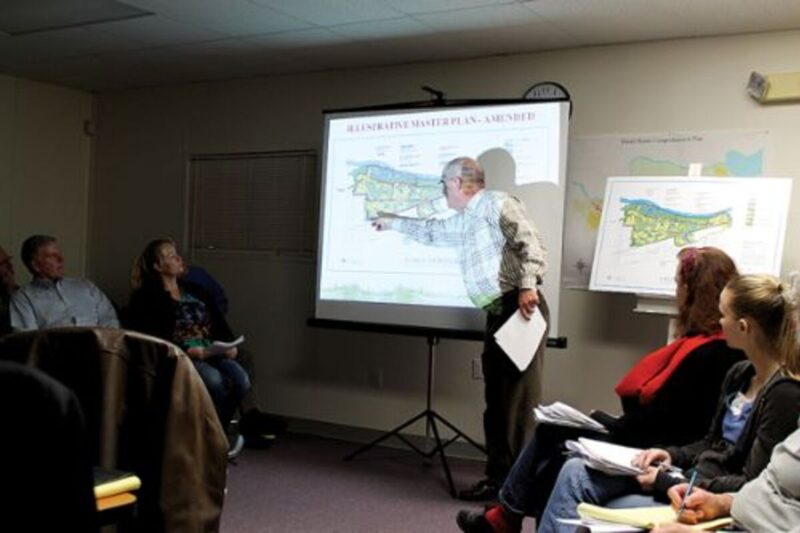Sean C. Morgan
The Sweet Home Planning Commission Monday night approved a master plan amendment for the Santiam River Place, nearly doubling the previously approved density for the 305-acre property.
The Planning Commission voted 4-1 to approve the amendment. Voting yes were Greg Stephens, Al Culver, Mike E. Adams and Eva Jurney. Lance Gatchell abstained, and Chairman Henry Wolthuis abstained except to break a tie. Anay Hausner voted no because the motion required the commission to review and approve findings of fact at next month’s regular meeting. She said she supported the proposal but thought the commission should simply approve it.
The property had been part of a larger master plan called “Santiam – a Master Planned Community in Sweet Home,” which was approved on July 26, 2004. That master plan included 441 acres owned by Western States Land Reliance Trust and managed by Dan Desler. Linn County foreclosed the WSLRT property at the end of 2010 for nonpayment of property taxes.
The 311 acres to the east of the WSLRT property was owned by Development by Design, which included Desler as a partner. The Santiam River Development Company bought 100 percent of Development by Design’s interest in the property in 2006. Santiam River Development Company is a partnership between Santiam River Partners LLC, led by Troy Cummins, and Destination Development Group, LLC, of which Phil Ordway is CEO and one of the owners.
At that time, they completely separated from Desler, WSLRT and Development Design, although they continued to work within the boundaries of the overall master plan. Their portion of the master plan was intended as a gated community called Santiam River Club, which included second homes and vacation homes 4,500 square feet and larger that would cost upward of $700,000 to $800,000.
Santiam River Place will not generally be gated, although it will have private roads which could be gated, but Ordway said he doesn’t believe any will.
A good portion of the property will now be open to the public, Ordway said. It will contain a full spectrum of healthcare facilities to address a potential influx of Baby Boomers. It will have somewhat smaller homes, closer to 2,500 square feet, and cost less than $350,000, with some of them well under $200,000.
“This is going to be a community that is part of Sweet Home rather than separate,” Ordway said.
Santiam River Place is generally bounded by Clark Mill Road to the west, the South Santiam River to the north, the railroad track to the south and Wiley Creek to the east. It includes 305 acres, as more than five acres have been donated to the city so it could build a new water treatment plant.
The original master plan included 633 units. The amendment allows 1,250 units, which results in a density of 4.1 units per acre, with a maximum density in one area of the plan for 7.8 units per acre. In a planned development, units may be arranged in unusual ways to allow developers to be creative with open space and other features of the development. This development will include clustered housing.
The maximum density for single family housing is 5.4 units per acre in the underlying zone and would allow 1,647 units, said city Community Development Director Carol Lewis. For multifamily housing, the maximum density would allow up to an “at some level – ridiculous” 10,665 units.
The development includes single-family and multi-family housing in eight different areas, each of which would return to the Planning Commission for subdivision approval.
“You are still well under your density for the entire property at this point,” Lewis said.
It also includes up to 240,000 square feet of non-residential structures and 34 acres set aside as sanctuary and riparian zone.
One 66-lot subdivision is already approved inside the development.
Requests
The Santiam River Development Company asked the Planning Commission to give it its own master plan.
It asked for more housing units to offset the reduction in home sizes and prices the homes will carry.
It asked for additional specific land uses, including medical facilities, offices and maintenance buildings.
It asked that the new plan not require construction to resume until after May 2015 to allow time to gather capital and the market to recover further. Ordway said he would like to see construction begin before that if possible.
The partners have already spent nearly $1.5 million in site preparation, engineering and consulting, Ordway said.
Reasons for
Amending the Plan
Ordway told the Planning Commission there were several reasons to amend the plan.
First was the change in ownership, he said. In 2006, Ordway, Cummins and their businesses separated themselves from the WSLRT and the trust property, now owned by Linn County.
The original plan was to create the upscale Santiam River Club, but the target market has changed dramatically since the plan was approved, which is also one of the reasons it went on hold.
“All of that changed with the, I call it, ‘the Great Depression of 2008,’” Ordway said, adding that the partners were already seeing signs of the market drying up in the second quarter of 2007 and decided to pull back. The recession ate up retirement funds.
“Baby Boomers are now focusing on whether they have enough money for retirement,” Ordway said. They lost interest in second homes and vacation homes. Their children saw what happened, and they’re not interested either.
That means they had to make drastic changes in their marketing, opening the community up to the public, adding amenities, such as healthcare facilities. There would be no more “club,” Ordway said. Smaller, less-expensive homes are meant to appeal to a market within four hours driving distance from Sweet Home.
It will include clustered neighborhoods while preserving open spaces, wetlands and sensitive areas, Ordway said, essentially a nature preserve where humans are slowly introduced. It may include some upscale apartments and condominiums, a boutique hotel or lodge and a high quality RV resort and residential community. The lodge site will include a community center and, possibly, a hotel.
With a reduction in per-unit prices, to earn a reasonable rate of return, Ordway said, the development needed to increase density.
Overall, the density shift won’t affect open spaces and natural areas, he said. The houses will be smaller.
“There is a great opportunity with this property to reclaim and restore it,” Ordway said. While attractive in its own right, it is close to Portland, the coast, two universities and more. Traffic is light, and commutes into the I-5 corridor are shorter and easier than the big cities.
“I think we’re all at a tipping point,” Ordway said. “Sweet Home is not going to be thought of as a mill town anymore. It’s going to be a place to go to have fun.”
And the guiding principles that drove the project in 2004 will continue into this project – protecting and improving the natural landscape, cleaning up and enhancing the ponds and habitat and removal of exotic vegetation.
Over a 10-year buildout, the development should pay out an estimated $28.4 million in wages, with 450 direct construction jobs and 300 indirect, Ordway said. In 10 years, it should provide some 845 full-time equivalent jobs and generate $25.4 million in wages per year.
It would add $3 million in taxes for the city while costing only $1 million in additional expenses, he said. It will also raise $2.4 million for School District 55 while costing the district about $1.2 million.
Testimony
Economic Development Director Brian Hoffman testified in favor of the amendment.
“We do have shovel-ready residential sites, especially destination-resorts like this one,” he said. “It’s a competitive advantage we have over other places.”
Sherri Gregory, a real estate agent with the Keller Williams Realty Group, also testified in favor of the project.
“They’ve done their homework,” Gregory said. “They know what’s going to work and what won’t work.’
Chuck Fitzsimons testified in opposition. He owns property outside the city limits next to the proposed development.
“It seems to me it’s about the money,” Fitzsimons said. “They’re taking the whole picture and trying to shove it into half. If you look at the density, it’s too much. We’re squeezing things tighter to make a profit.”
He added he hoped the partners do make a profit.
He said that no one has kept the property mowed.
“I want to know why the city isn’t enforcing the fire code,” Fitzsimons said. He said temperatures will reach record highs for the next 10 years, and last summer brush in the area was 8 feet tall.
His wife, Roseanne Lupoli, noted that the new plan nearly doubles the previously approved density.
“The issue of density is understandable,” Ordway said. “We have a fiduciary duty to our investors. We’re not here to put 10 pounds in a 5-pound sack.”
But they are looking for a reasonable rate of return, he said. They have nearly twice as many homes, but it’s taking about the same amount of land.
He added that the property has been mowed in compliance with the city’s standards.
The city requires property be mowed within 50 feet of developed property.
“We are scared to death of fire on our property,” Ordway said.
He also noted that trespassers are a problem.
Planning Commission Discussion
The plan includes a trail that would run east and west along the length of the development. That trail would likely become part of the Santiam Community Forest corridor, connecting Sweet Home to the Willamette National Forest east of Cascadia.
A provision in the plan would allow the homeowners association to close it under certain circumstances, if litter, vandalism and crime become big problems.
Trails to the north through the neighborhoods with private road systems would remain private trails, for residents and their guests to use.
During their discussion, planning commissioners were concerned about closing the public east-west trail and providing public access to the South Santiam River.
“I’m not really crazy about the ability to close the trail without something real serious,” Stephens said.
“We are concerned about your concerns,” Wolthuis said, but he added he would like to see some public access.
Adams said he understands the concerns, noting that closing the east-west trail would drive people to the roads.
It’s private property though, Adams said. “Is that the Planning Commission’s decision? No, because it’s private property.”
He added that there are public accesses at Wiley Creek and Northside Park. Linn County is discussing public access through a proposed park on the old trust property. Still, he thought it would be a good thing if the applicants could address the concerns about the east-west trail.
Adams said he had no problem with the request to begin construction in 2015.
Gatchell said he supported more public access, as it would benefit Sweet Home, but he realized it wasn’t the commission’s decision. “For livability for the whole town, it’s nice when we have more public access,” he said.
Jurney agreed that two years on a project like this is a short amount of time and had no problem with the 2015 construction deadline.
“Yes, we’d like to see them starting tomorrow,” she said, although it’s unlikely.
She also had no problem with the new densities but wondered how such a large population growth would impact the city.
“I moved here because it’s a small town,” Jurney said.
She also agreed with the comments about the trails.
“We realize you are dealing with private property, and we are in no position to dictate what you do with private property,” Wolthuis said, but he asked the developers to do something voluntarily. “I’m empathetic. We just ask you to maybe take a look at that language.”
Ordway told the commission that closing any of it is unlikely, but law enforcement support could help ensure it stays open.
They can’t keep people from walking the streets, Cummins said, so he asked what the difference is with the east-west trail. It’s a public trail.
He was not in favor of opening up the trails to the north, he said.
Culver and Hausner did not add any discussion before the vote.
The commission’s decision includes variances for lot sizes of 5,000 for single-family cottage and patio homes. Those homes would require a side setback area of 0 feet with a 13-foot setback from each other.





